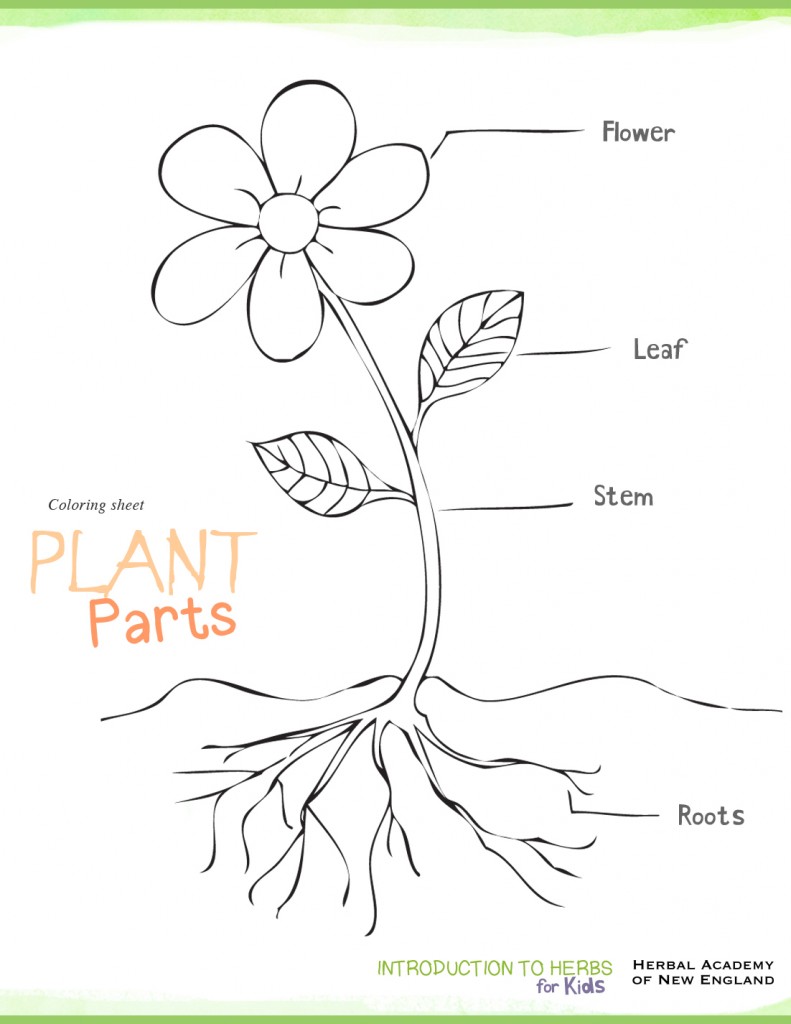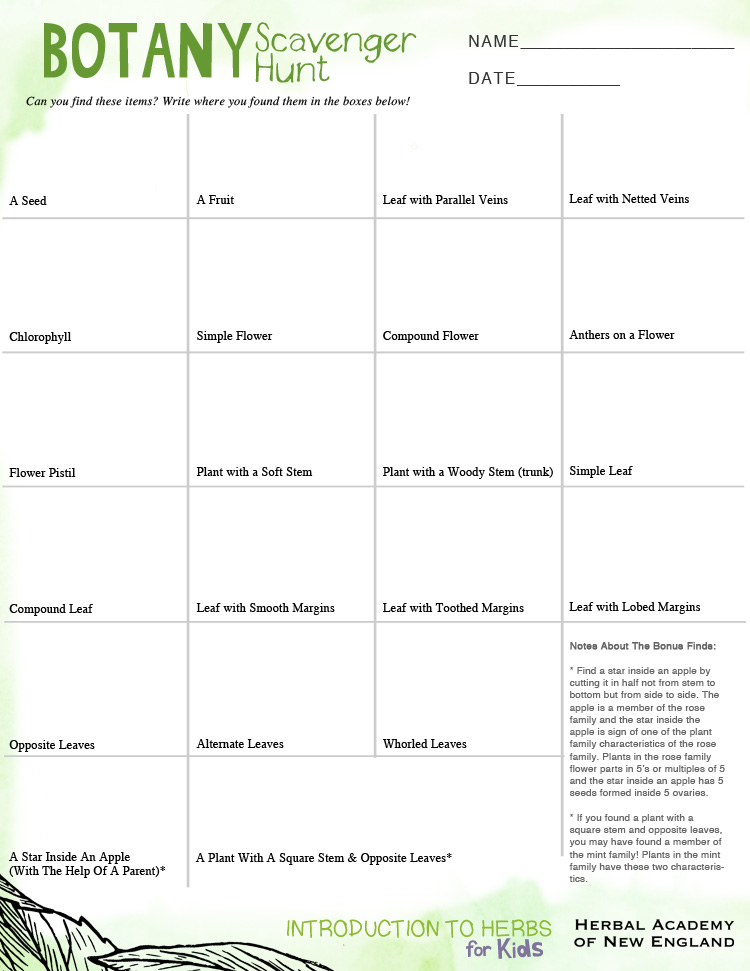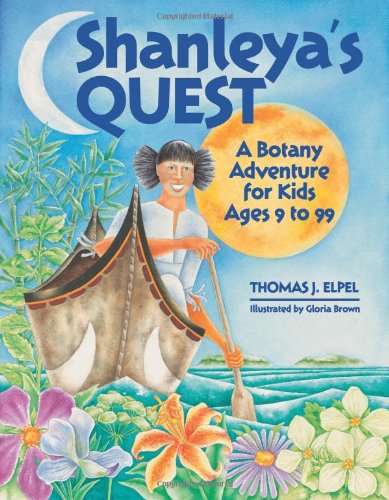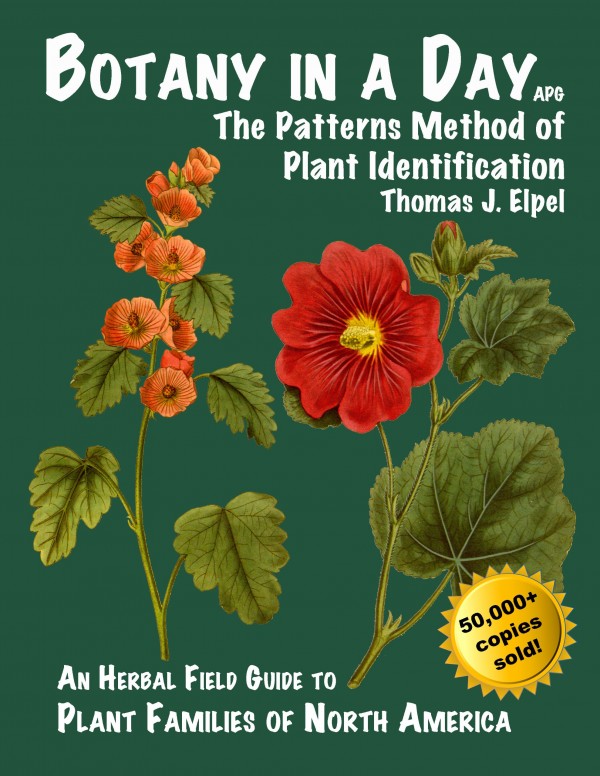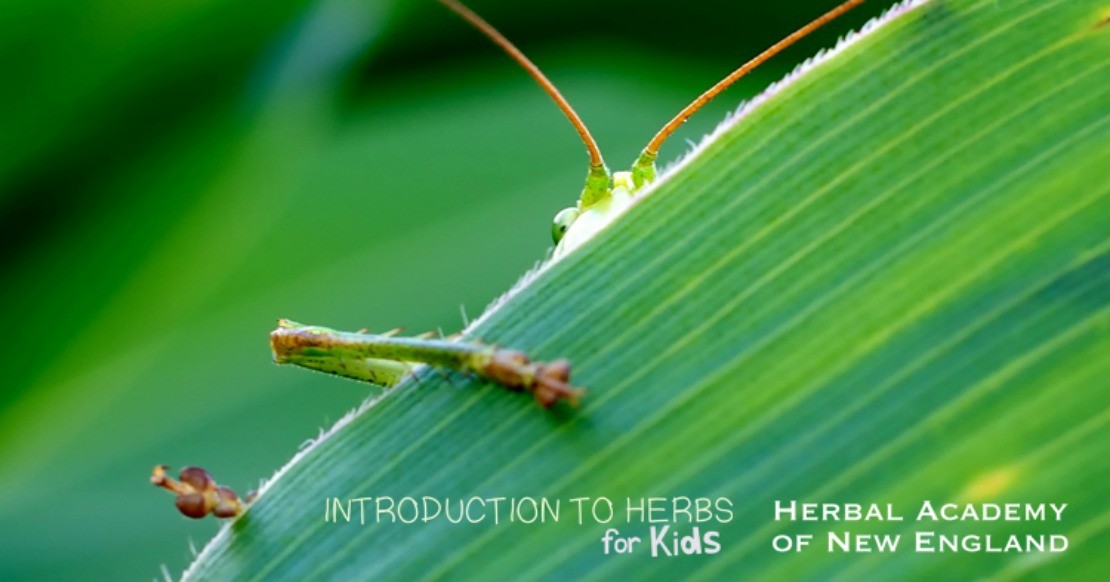
Introduction to Herbs for Kids: Meet My Friend, Herb! Part 2
Meet My Friend, Herb! Part Two
Welcome! Thank you for joining us on our herbal adventure! In our last Introduction to Herbs for Kids lesson, we started learning about herbalism by answering questions such as “What is an herb?” and “How can I use herbs?” This week we are going to talk about a very special part of science that herbalists love because it is all about plants!
What do you know about plants? Do you know about the parts of plants? Do you know that plants have silly names? To learn about herbalism, it is important to know about plants. In fact, being an herbalist is like being part artist and part scientist. A great way to begin to be a scientist is to learn about botany.
Botany is a part of science that focuses on the study of plants. Knowing some basic botany helps herbalists to recognize plants, which is mighty helpful. Also, knowing about botany helps you understand the language of plants and the language herbalists use.

Special Botanical Terms
When learning about botany and herbs, you will encounter many interesting and sometimes strange words.
Here is a key to help you understand some of the words in this article.
- Botany: A branch of science that is focused on the study of plants.
- Carbon Dioxide: A gas produced by people and animals that is part of the air that is exhaled with each breath. It is used by plants for the process of photosynthesis. Scientists use the symbol CO2 to symbolize carbon dioxide.
- Chlorophyll: A green pigment (color) inside plants that captures light energy for photosynthesis.
- Genus Name: In botany, the genus name is the first part of the Latin name for a plant. The latin name for violet is Viola odorata, so the genus name is Viola.
- Oxygen: A gas that is a product of photosynthesis and is essential for people and animals to have in their air. It is used in the body of people and animals as part of the chemical reaction that releases energy from food. Scientists use the symbol O2 to symbolize oxygen.
- Photosynthesis: The word photosynthesis can be broken down into the two words, photo and synthesis. Photo means light and synthesis means to make or put together. So photosynthesis means to make with light. And plants do just that! Using sunlight, water and carbon dioxide, plants makes food and oxygen.
- Plant Family Characteristics: These are patterns that occur in plants which help botanists group plants into families.
- Pollination: Pollination is the transfer of pollen from one flower to another, resulting in fertilization that allows the plant to reproduce by making seeds which grow into baby plants.
Part Of Plants
Just like us, plants have a variety of different body parts. These parts all have special, important functions that help the plant live a strong, healthy life. For instance, your legs help you to stand and carry you where you would like to go. Your hands and arms help you give hugs, color a picture, read a book, and so much more.
Can you name some plant parts? How do you think these parts help the plant?
Download and print the Plant Parts Coloring sheet.
Roots
This amazing plant part grows underground, so is hidden from view. Plant roots hold the plant firmly and strongly in the Earth’s soil. The roots also drink up water, vitamins, and minerals from the ground and move them up into the leaves for photosynthesis.
Leaves
Inside the leaves of a plant magic is happening. The leaves catch energy from the sun’s rays to make food for the plant! Can you imagine that? We have to eat food for energy, but plants make their own food.
How does this happen? The leaves are filled with a substance called chlorophyll which is what makes the leaves green. Energy from sunlight is caught inside the chlorophyll. This energy is combined with water absorbed through the plant’s roots and carbon dioxide from the air surrounding the leaves. All of these ingredients combine to create sugars for the plant as well as oxygen which is released into the air. Scientists call this amazing process photosynthesis: water + carbon dioxide + sunlight = sugars + oxygen.

Stems & Trunks
The stems and trunks of plants provide support for leaves, flowers, and fruits. Inside these supportive structures there is a lot of movement going on. The nutrients (vitamins and minerals) absorbed through the roots are drawn all the way up to the leaves for photosynthesis. At the same time, the food created during photosynthesis travels through the stem (or trunk) to help feed all the parts of the plant.
How do you think a trunk is different from a stem? Think of a tree compared to a flower stem. The tree trunk is made of wood while the flower stem is made of softer plant material. Both the tree trunk and the flower stem serve the same purpose. Yet, the tree trunk also serves as a steady support throughout the years while the flower stem will fade and die at the end of the growing season.
Flowers
Flowers are beautiful and lovely, aren’t they? Well bees, butterflies and hummingbirds think so, too! These animals are attracted to flowers, much as we are, and inside flowers they find pollen and nectar to eat. While they dine, they get covered in pollen and they carry the pollen to their meal at the next flower. This is great for the plants because they need their pollen to be all spread around so they can be fertilized. When the pollen is transferred like this it helps the plant to make seeds!
Fruits
Fruits form from flowers and hold safe inside them the plant’s seeds. Fruits are a way for the seeds to get around. When people or animals eat fruit, they usually move away from the parent plant and then deposit the seeds elsewhere. You do this too when you eat an apple or peach and then toss the core or pit in your garden or compost pile!
Seeds
Seeds carry within them the opportunity for a new plant to grow. Seeds are full of starchy nutrients to help the new little plant grow because, at first, the plant will not be able to make its own food.
Sometimes seeds form inside fruits and sometimes they form without a fruit covering. Often times these seeds get around by using the power of the wind. Have you ever made a wish while blowing on a fuzzy-headed dandelion? What you are blowing off into the air are hundreds of dandelion seeds.
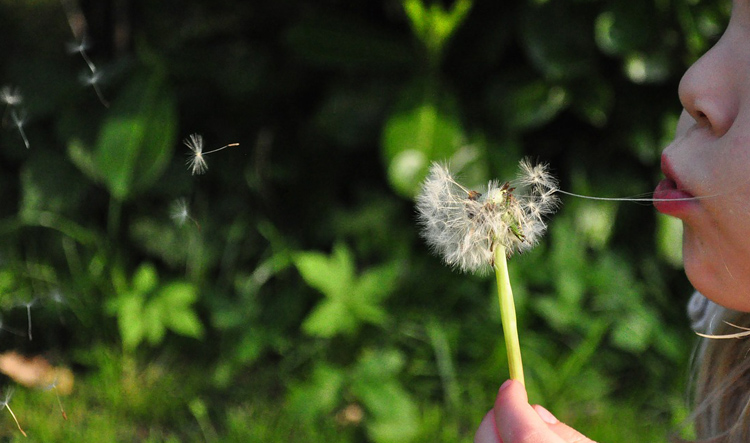
Shapes & Patterns
Botanists have a lot of funny terms to help them describe and identify plants. There are way too many leaf shapes, flower types, patterns and terms for us to be able to talk about all of them here. Some of the easiest plant parts to consider when identifying plants are the leaves and the flowers. So we will start by getting familiar with those!
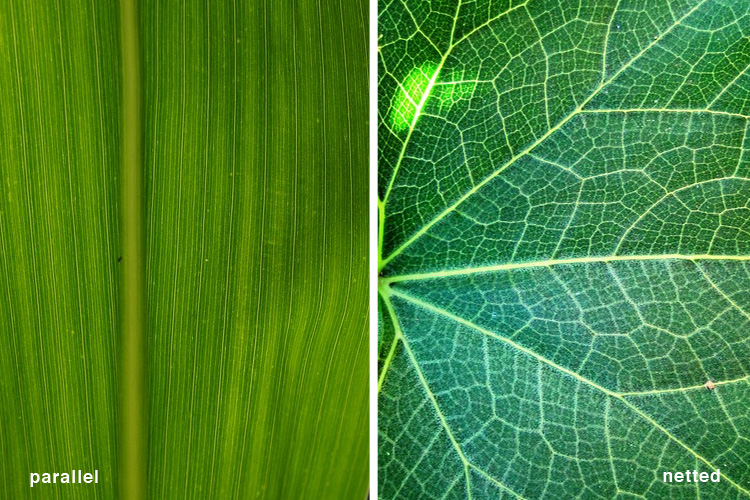
Leaf Veins
The veins are the lines you see in leaves. The veins can either run parallel to each other or they can be netted.
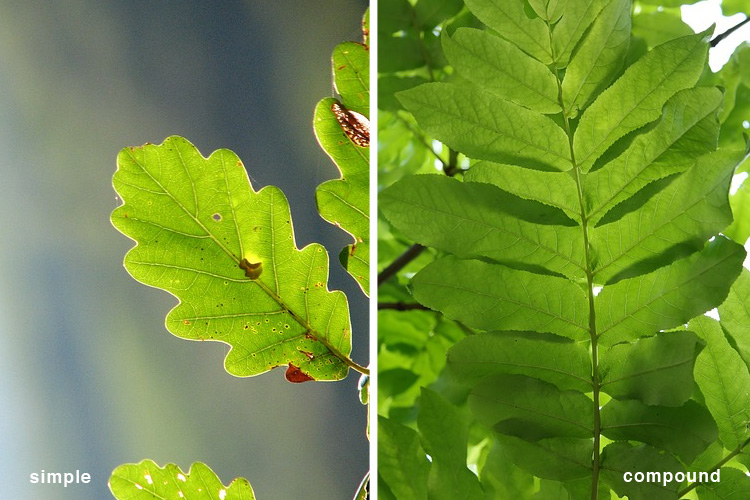
Simple & Compound Leaves
A simple leaf is a leaf made of one part while a compound leaf will have many little leaflets all attached to create one leaf.
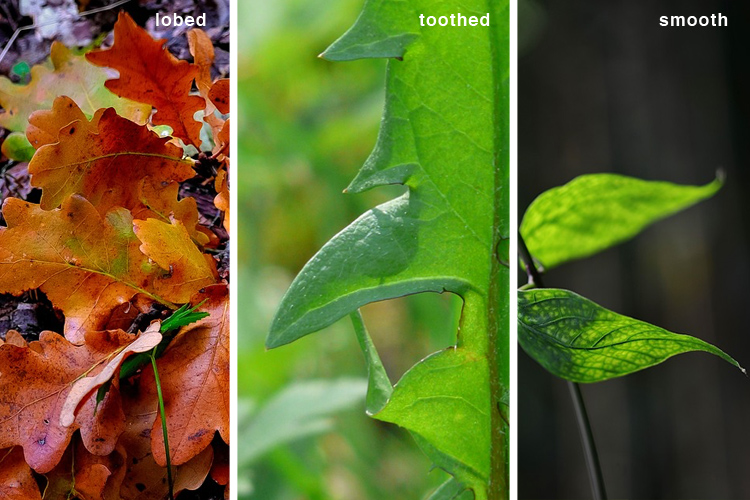
Leaf Margins
This is the edges of leaves and what they look like. The edges can be smooth, lobed, or toothed like a dandelion’s leaf.
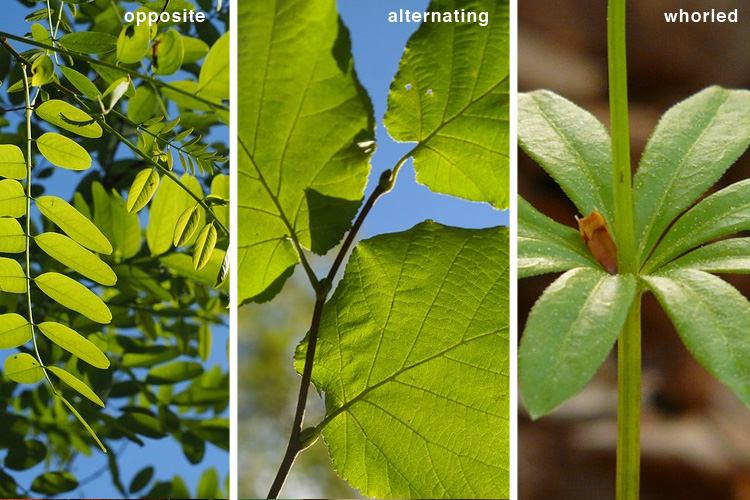
Leaf Arrangement
Leaves are arranged on plant stems either opposite from each other, alternating in their placement along the stem, or whorled in circles.
Download the Flower Parts Coloring Sheet.
Flower Parts
Flowers are more than just nice smelling petals. If you look inside a flower, you will find that a lot is going on. The function of the flower is to make seeds either by attracting pollinators or through self-pollination. Even though flowers come in all kinds of shapes, sizes, and colors, when you look in the center of a flower you will find stamens and pistils which are essential for pollination.
Stamens are composed of two parts, the anther and the filament. The anthers sit atop the filament and are where you will find pollen. A flower can have just a few anthers or many.
The pistil is where the pollen lands, fertilizing the flower to make seeds. The pistil is made up of three parts. They are the stigma, style, and ovary. A flower can have one pistil or many.
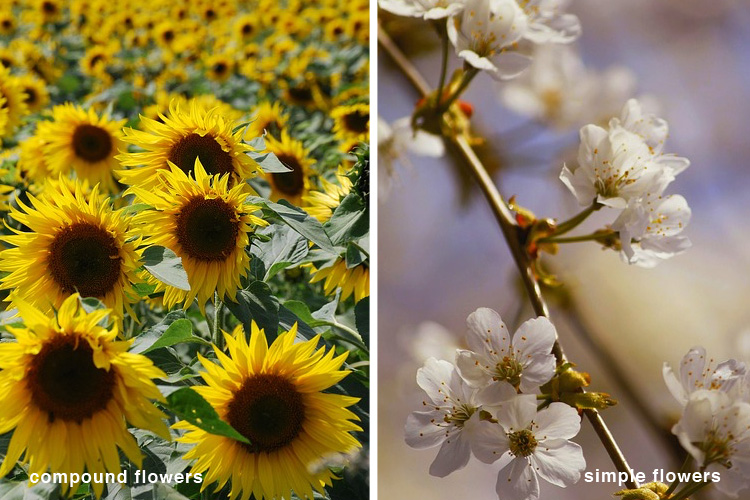
Flower Types
Flowers are amazing. There are so many different kinds of enchanting flowers in the world. Yet, they can be broken down into two groups: simple flowers and compound flowers. Simple flowers are made up of one flower like an apple blossom or a violet. Compound flowers are really many, many, tiny flowers all clustered together even though they look like a single flower. Examples of compound flowers are chamomile and sunflowers.
What’s In A Name?
Every plant has a very special two part name. The special name is in a language called Latin and knowing this name will help you know if the plant you are buying, planting, or talking to is the plant you want. Plants also have other names called common names, which can be in any language. Their family has a Latin name and a common name too!
The first name you will see listed for a plant is the genus name and many plants in the same group can share the same genus name. The second name you see listed will tell you the specific name of the plant. It is similar to how we have two names. There can be lots of girls named Jennifer yet if you put the last name with the first name, then you know which special Jennifer you are referring to.
For example, here are two plant names to consider: Viola odorata and Viola tricolor. These plants are both in the same plant family (Violaceae) and Genus (Viola) and have similar properties in herbal medicine, yet they are different plants. Viola odorata is most commonly known as violet and Viola tricolor is most commonly known as pansy.
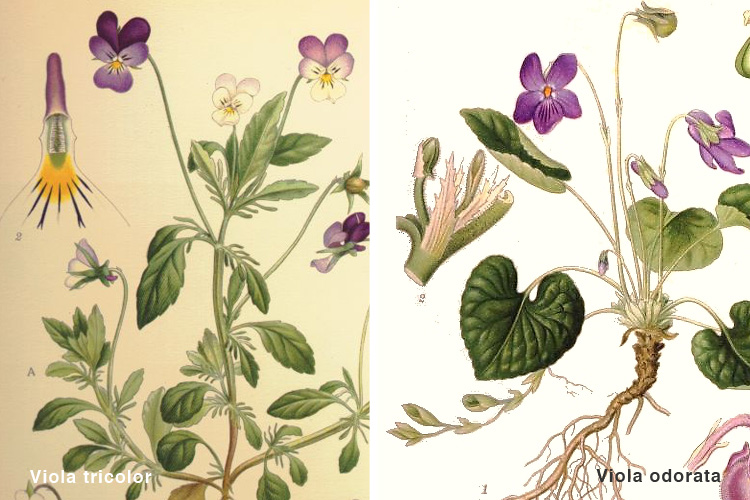
Why is this important? Sometimes different plants will have the same common name. Even though these plants have the same common name they can be very different plants, having very different actions in herbal medicine. So you need to know you have the right plant and knowing the plant’s Latin name can help you do just that.
Plants Have Families, Too
Did you know that plants have families? Some of my favorite plant families are the mint family, the rose family, and the sunflower family. Botanists group plants into families based on patterns among the plants. These patterns are often called family characteristics. It is similar to how people in families can look like one another. For example, plants in the rose family have 5 petals on the flowers. Plants in the mint family have square stems and leaves that are arranged on the stem in pairs that are opposite to each other, like your arms are on your body. And guess what? Plant families have their very own Latin names too, just like the plants!
Role Call!
Herbal Friends & Their Silly Names
| Common Name | Genus | Species | Latin Family Name | Common Family Name |
| Chamomile | Matricaria | chamomilla | Asteraceae | Sunflower |
| Calendula | Calendula | officinalis | Asteraceae | Sunflower |
| Lemon Balm | Melissa | officinalis | Lamiaceae | Mint |
| Lavender | Lavandula | officinalis | Lamiaceae | Mint |
| Peppermint | Mentha | piperita | Lamiaceae | Mint |
| Rose | Rosa | rugosa | Rosaceae | Rose |
| Violet | Viola | odorata | Violaceae | Violet |
| Marshmallow | Althea | officinalis | Malvaceae | Mallow |
Activities For Kids Of All Ages
These activities are wonderful for kids of all ages. Younger children will need some adult help, but they will surely be fascinated by what the discover!
Watch A Seed In Action
Have you ever cut open an avocado and discovered the big slippery seed inside? With a little special care you can help an avocado seed sprout and even grow into a little tree.
Materials:
- 1 avocado
- toothpicks
- clear glass or jar of water
Instructions: Wash and dry the avocado seed. Firmly insert three to 4 toothpicks evenly spaced around the middle of the avocado with the wide end pointing down. (Young kids will need help with this!) Dangle the avocado into the glass or jar by using the toothpicks as support. The bottom of the seed should be in the water. Be sure to maintain the water level and keep in a warm place out of direct light. In a few weeks you should see roots and a stem begin to sprout!
Flower Discovery
Observe this inner world of flowers and learn first-hand about the parts of a flower. This activity is all about observing what you find. Through careful observation, you should be able to find many flower parts.
Materials:
- at least 1 tulip or large lily
- knife and parent’s help for young kids
- magnifying glass, optional
- notebook & pencil, optional
Instructions: Take your big beautiful flower and examine it. You may want to take notes about what you see.
What do you see? Can you find any flower parts? Around the edge of the flower are the colorful petals. Right in the center is the pistil and those funny ball looking things, those are the anthers. Look at the anthers under a magnifying glass. Do you see little grains? That is the flower’s pollen. Next, gently pull the petals off your flower to reveal the bottom of the pistil. The swelling you see is the place where the seeds grow, called the ovary. Now with your knife (and your parent’s help), you can gently slice the pistil open. You may be able to use your magnifying glass to see small round structures at the base of the pistil. These are the ovules which will turn into seeds after pollination.
Leaf Rubbings
Make a beautiful image of a leaf to see the intricacies of the leaf’s veins.
Materials:
- thin paper, like printer paper
- crayons
- leaves, try to find a variety of leaves
Instructions: Gently spread out a leaf with the underside (veins) facing up on a hard surface. Place a piece of paper on top of the leaf. Remove the paper crayon covering, then place the crayon on it’s side and gently rub it over the top of the paper and watch as an image of the leaf appears before your eyes!
Scavenger Hunt
Invite your friends and family to join you. You either hunt together or make a friendly game of it and see who can find the most things from the list! As you hunt, you can either collect the items you find, take pictures of them, or just make a note about where you found it. Print out the Botany Scavenger Hunt for Kids form to take with you on your hunt!
Plants & Animals: How We Help Each Other
There is a magic circle of breath and energy between animals and plants on our beautiful Earth. Have you ever seen a picture that shows how the inside of our lungs looks like the upside down branches of a winter tree? We need each other for healthy breathing and indeed to survive.
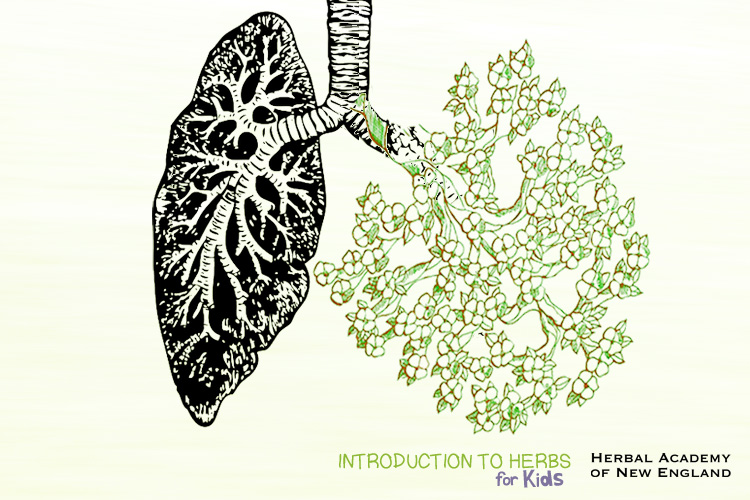
We already talked a little bit about photosynthesis, remember? The thing is that the process of photosynthesis is one of the incredible ways that plants support human and animal life on Earth. And in fact, in considering photosynthesis, we can see how people and animals support plants as well.
Remember that plants use carbon dioxide from the surrounding air for photosynthesis? They get the carbon dioxide from the very air we exhale! Carbon dioxide is formed inside the cells of our body as part of the process that liberates energy from the food we eat. So when we breath out, we are helping the plants around us grow by giving them the carbon dioxide they need for photosynthesis.
Guess what? That process deep inside our cells that produces carbon dioxide requires oxygen, which is a gas we get from the air we breath. And plants make the very oxygen we need! It is a circle of breathing and energy between people, animals and plants on our beautiful Earth. We are interconnected through our breath!
Activity For Interconnected Breathing:
This is a simple yet profound exercise. This is best done sitting outside, perhaps leaning against a big tree or laying in a lovely patch of plants. Being by taking a few big breaths deep into your tummy. Breath in through your nose and out through your mouth. It may help to put your hands on your stomach and feel it rising with your breath.
Now imagine the circle you are making with your breath. You are breathing in life-giving oxygen produced by our green friends, the plants. Breathe deep and feel the oxygen coming into every cell of your body. As you breathe out, exhale a breath of thank you to the plants as you offer them life-giving carbon dioxide. Take a few more breaths in and out, imagining that circle and feeling the connection we share with them.
If you want to learn more about botany and how to identify plants check out:
|
|
|
Note To Parents
Thank you for joining us on another herbal adventure. Our exploration of botany was designed to give kids an approachable introduction to the science of plants. This is a vast subject in itself and can be a wonderful topic for further exploration.
As herbalists, we speak the language of plants. We talk about what part of the plant we are using in our remedies. We talk about where the plant grows and what it looks like. Botany gives us a common language to describe what we see and to share with one another.
The study of botany helps to opens one’s eyes to details in the plant world that might otherwise go unnoticed. Details such as leaf texture — is the leaf smooth or does it have hairs? Are the hairs soft and downy or are they stiff hispid hairs? How do the leaves appear on the plant? Are they present in an alternating, opposite, or whorled pattern? What does this tell us about the plant? Using plant identification keys, these details will help us identify the plant we are looking at. Take it a bit further and you will find that plants in certain families really do share common characteristics. When encountering a new plant, knowledge of these characteristics instantly helps us make an educated guess as to which plant family our new friend belongs and also what healing properties it may posses.
Please note that some of the activities offered require parental guidance and in particular help for small children with toothpicks (Watch A Seed In Action) and a knife (Flower Discovery).
Beyond trying out some of the activities listed there are many ways to support your child in their learning about botany. Take the scavenger hunt with your child and see what you can find. Visit your local botanical garden. Most botanical gardens offer classes for kids as well. There are also many books about botany for kids which can offer a deeper look into this fascinating subject!
A Reminder: Safety First! Please help your kids be safe when using herbs. It is important that kids be supervised when using herbs, especially if they are very small. Instruct your child(ren) to always check with you first before handling or ingesting any plants. We will be talking about herbs that are generally considered to be safe for children. If your child is a sensitive soul or has allergies, you should consider doing a “scratch test” with them when introducing each new herb. To do a scratch test, take a small amount of the herb and rub it on your child’s inner arm. Wait 24 hours to see if there is any reaction before using the herb with your child.
Parents, do you want to expand your learning about herbalism? Here at the Herbal Academy of New England, we offer both Introductory and Intermediate Herbal Courses for online learning. We also offer The Herbarium, an extensive membership website that features herbal monographs and so much more! Membership to The Herbarium offers a wonderful resource for herbalists and students alike.

